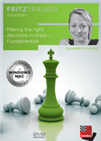Colour imbalance
A tumultuous start led to a somewhat underwhelming atmosphere at the third leg of the Women’s Grand Prix series in New Delhi. Organizational issues prompted Zhansaya Abdumalik’s withdrawal from the tournament, while the ensuing handling of the conflict led to Elisabeth Paehtz also deciding to withdraw. Ten players agreed to participate despite the circumstances, albeit not in balanced conditions, as the pairings were not rearranged to secure a fair balance of colour allocations — i.e. two players had 6 whites and 3 blacks in the event, while two players, inversely, had to play 6 times with black.
 In a total of 6 chapters, we look at the following aspects: the right decision based on tactical factors, decisions in exchanges and moves, complex and psychological decisions in longer games and in defence.
In a total of 6 chapters, we look at the following aspects: the right decision based on tactical factors, decisions in exchanges and moves, complex and psychological decisions in longer games and in defence.FIDE President Arkadiy Dvorkovich did take some of the blame, but his apology does not take away from the fact that this was a major blow to the Women’s World Championship cycle. The series grants two places for the next edition of the Candidates Tournament, the prelude to the all-important match for the world title. Not only did the withdrawals left Abdumalik and Paehtz fully out of contention, but also affected the participants who had to play a disproportionate number of games with black in New Delhi.
Moreover, “broader issues regarding other events” were also brought up, hinting at possible systemic issues in the women’s circuit. All this follows Anna and Mariya Muzychuk’s withdrawal from the event, which might be related to the war in Ukraine and the participation of Russian players — no public statements have been made regarding this issue, and last week FIDE announced that the fourth leg of the series will take place next month in Cyprus, listing both Muzychuk sisters and four Russian players in the lineup.
Zhu and Assaubayeva earn GM norms
Nine rounds of classical rated games were notwithstanding played in New Delhi, and the two youngest participants achieved remarkable results. Zhu Jiner (20 years old) and Bibisara Assaubayeva (19) both scored 6/9 points and grabbed GM norms in the event. For Zhu, this was her third and final norm. Zhu also gained 17.6 rating points, and thus surpassed the 2500-rating mark, which is also a condition to receive the GM title.
 Let us learn together how to find the best spot for the queen in the early middle�game, how to navigate this piece around the board, how to time the queen attack, how to decide whether to exchange it or not, and much more!
Let us learn together how to find the best spot for the queen in the early middle�game, how to navigate this piece around the board, how to time the queen attack, how to decide whether to exchange it or not, and much more!Zhu climbed to 11th place in the women’s live ratings list, further highlighting China’s preeminence at the very top of the women’s circuit — out of the 13 players rated 2500 or above, 5 hail from the Asian country, including Hou Yifan (the highest-rated player in the world), Ju Wenjun (the current world champion) and Lei Tingjie (Ju’s challenger in the upcoming match for the world title).
Both Zhu and Assaubayeva played six games with white in New Delhi.

Bibisara Assaubayeva has two GM norms at 19 | Photo: FIDE / Ismael Nieto
In round 10, Zhu got the better of Vaishali Rameshbabu. The Chinese gained a positional advantage out of the opening and finished the game with a mating attack.
29.Ne4 leaves both the rook on e8 and the pawn on c4 en prise — but checkmate wins the game, after all. Vaishali resigned after 29...Nxc4 30.Nf6+ Kg7 31.Qe7.

The new Chinese superstar — Zhu Jiner | Photo: FIDE / Ismael Nieto
Goryachkina is declared winner
The last Women’s World Championship challenger, Aleksandra Goryachkina, entered the tournament as the second seed, only behind Humpy Koneru. Much like Zhu, the Russian collected three wins and six draws to end the tournament with 6/9 points (Assaubayeva lost to Goryachkina). Based on tiebreak criteria, Goryachkina was declared the tournament winner.
Goryachkina beat Nino Batsiashvili with black in round 7. Batsiashvili found herself in a losing position as early as on move 14.
13.b4 was a bold pawn push by the Georgian GM, and not one that was positively evaluated by the engines. However, only after 13...cxb4 did White play the actual losing move: 14.Nb5
Batsiashvili surely calculated that the discovered check with 14...b3+ can be replied by 15.c3, and not only the knight protects that square but also threatens to gain a tempo by giving a check from d6.
 This DVD allows you to learn from the example of one of the best players in the history of chess and from the explanations of the authors (Pelletier, Marin, Müller and Reeh) how to successfully organise your games strategically, consequently how to keep y
This DVD allows you to learn from the example of one of the best players in the history of chess and from the explanations of the authors (Pelletier, Marin, Müller and Reeh) how to successfully organise your games strategically, consequently how to keep yWhat the Georgian missed, though, was 14...Bxc2, a killer zwischenzug. After noticing her mistake, Batsiashvili thought for 12 minutes before giving up her queen with 15.Qxc2. The game continued until move 33, but the result was never in doubt — an extra queen is too much of an advantage for a player of Goryachkina’s calibre.

Yet another trophy for the very accomplished Aleksandra Goryachkina | Photo: Ismael Nieto
Final standings
All games
Links


























